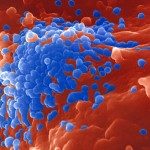Link to Pubmed [PMID] – 20463074
J. Virol. 2010 Jul;84(14):7278-87
Human T-cell leukemia virus type 1 (HTLV-1) induces cell proliferation after infection, leading to efficient transmission by cell-to-cell contact. After a long latent period, a fraction of carriers develop adult T-cell leukemia (ATL). Genetic changes in the tax gene in ATL cells were reported in about 10% of ATL cases. To determine genetic changes that may occur throughout the provirus, we determined the entire sequence of the HTLV-1 provirus in 60 ATL cases. Abortive genetic changes, including deletions, insertions, and nonsense mutations, were frequent in all viral genes except the HBZ gene, which is transcribed from the minus strand of the virus. G-to-A base substitutions were the most frequent mutations in ATL cells. The sequence context of G-to-A mutations was in accordance with the preferred target sequence of human APOBEC3G (hA3G). The target sequences of hA3G were less frequent in the plus strand of the HBZ coding region than in other coding regions of the HTLV-1 provirus. Nonsense mutations in viral genes including tax were also observed in proviruses from asymptomatic carriers, indicating that these mutations were generated during reverse transcription and prior to oncogenesis. The fact that hA3G targets the minus strand during reverse transcription explains why the HBZ gene is not susceptible to such nonsense mutations. HTLV-1-infected cells likely take advantage of hA3G to escape from the host immune system by losing expression of viral proteins.

